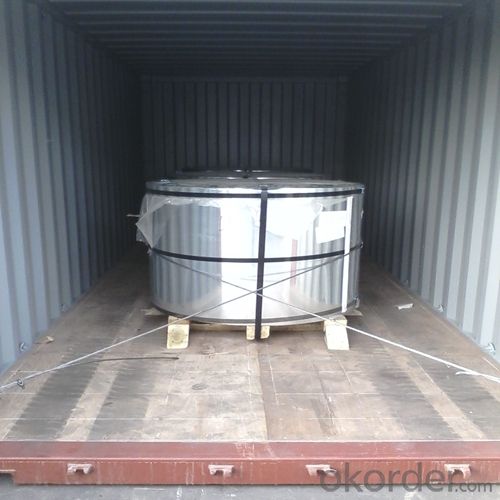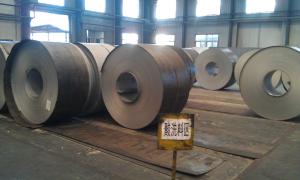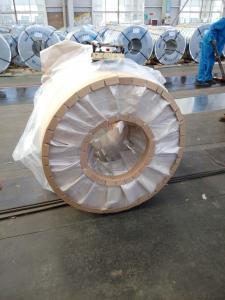Electrolytic Tinplate of Prime Quality for Useage of Chemical or Industrial Package
- Loading Port:
- Tianjin
- Payment Terms:
- TT OR LC
- Min Order Qty:
- 50 m.t.
- Supply Capability:
- 30000 m.t./month
OKorder Service Pledge
OKorder Financial Service
You Might Also Like
Item specifice
1.Structure of Electrolytic Tinplate of Prime Quality for Useage of Chemical or Industrial Package Description
Electrolytic Tinplate undoubtedly enjoys the pride of place as a packaging medium especially for food. It owes its unique position to its "nine layer sandwich structure", each of which contributes to its eminence as a packing material. The steel base of electrolytic tinplate provides the necessary strength and formability for can fabrication. The tin-iron alloy layer provides the bond between the steel and free tin layer. The free tin layer is not only responsible for the attractive bright finish and ease of solderability but is also non-toxic- a factor of vital importance in food packaging!
2.Main Features of the Electrolytic Tinplate of Prime Quality for Useage of Chemical or Industrial Package
Type MR – These base steels are low in residual elements and have good corrosion resistance properties. These steels are widely used in general applications
Type L – In this type the base steel has extremely low residual elements (Cu, Ni, Co and Mo). These steels have very good corrosion resistance to certain types of food products.
Type D – In D type aluminum killed base steel is used. These types are used in applications involving deep drawing or other types of severe forming that tend to give rise to Lueder’s lines.
3.Electrolytic Tinplate of Prime Quality for Useage of Chemical or Industrial Package Images


4.Electrolytic Tinplate of Prime Quality for Useage of Chemical or Industrial Package Specification
Specification of :
Standard: ISO 11949 -1995, GB/T2520-2000,JIS G3303,ASTM A623, BS EN 10202
Material: MR,SPCC
Thickness:0.15mm - 0.50mm
Width: 600mm -1150mm
Temper: T1-T5
Annealing: BA & CA
Coil Inner Diameter: 508mm
Weight: 6-10 tons/coil 1~1.7 tons/sheets bundle
Passivation:311
Oil: DOS
Surface: Finish,bright,stone,matte,silver
5.FAQ of Electrolytic Tinplate of Prime Quality for Useage of Chemical or Industrial Package
- What is tinning and how does it work?
Tinning is the process of thinly coating sheets of wrought iron or steel with tin, and the resulting product is known as tinplate. It is most often used to prevent rust.
- Do you only have prime quality tinplate?
We can supply both prime and second quality tinplate.
- Q:What's the difference between iron, aluminium, stainless steel, galvanized iron and tin?
- Iron is another kind of material. It is easy to be oxidized (embroidered) when it meets waterGalvanized sheet is made of iron, but zinc is plated on the surface to improve oxidation resistance. The price is cheap
- Q:How does tinplate packaging affect the shelf life of products?
- Tinplate packaging can significantly extend the shelf life of products. Tinplate is a durable and corrosion-resistant material that provides an effective barrier against moisture, oxygen, and light. This protective layer helps to prevent spoilage, maintain product quality, and prolong the freshness of food and other perishable items. Additionally, tinplate packaging offers enhanced protection against external contaminants, such as bacteria, ensuring the safety and integrity of the product throughout its shelf life.
- Q:How does tinplate contribute to the protection of musical instruments?
- Tinplate contributes to the protection of musical instruments by providing a durable and corrosion-resistant coating, which helps prevent rust and damage caused by moisture and environmental factors. Additionally, tinplate can be used in the manufacturing of instrument cases, offering a lightweight yet strong material that safeguards instruments during transportation and storage.
- Q:What are the typical lead times for tinplate production?
- The typical lead times for tinplate production can vary depending on various factors, such as the complexity of the product, order quantity, and the production capacity of the manufacturer. However, on average, lead times for tinplate production can range from a few weeks to a couple of months. It is recommended to consult with the specific manufacturer for more accurate and up-to-date information regarding lead times.
- Q:Can tinplate packaging be used for aerosol products?
- Yes, tinplate packaging can be used for aerosol products. Tinplate is a commonly used material for aerosol cans due to its durability and ability to withstand the pressure exerted by aerosol products. Additionally, tinplate provides a barrier against moisture and other external factors, ensuring the quality and safety of the aerosol contents.
- Q:How does tinplate packaging contribute to product protection during shipping?
- Tinplate packaging provides effective protection during shipping due to its durability and strength. It acts as a sturdy barrier against external elements, such as moisture, light, and air, which can potentially damage the product. Tinplate packaging also offers resistance to corrosion, ensuring the product's integrity throughout the shipping process. Its robust construction provides cushioning and prevents the product from being easily crushed or dented. Overall, tinplate packaging plays a crucial role in safeguarding the product from various risks, ensuring it reaches the destination in optimal condition.
- Q:What are the main challenges in tinplate welding and soldering?
- The main challenges in tinplate welding and soldering include achieving proper adhesion due to the thinness of the tin coating, ensuring the cleanliness of the surface to prevent contamination, and controlling the heat input to avoid warping or damaging the tinplate material. Additionally, the low melting point of tin can make it prone to overheating or burning, requiring careful temperature control during the welding or soldering process.
- Q:Can tinplate be used for packaging products with specific storage requirements?
- Yes, tinplate can be used for packaging products with specific storage requirements. Tinplate is a durable and corrosion-resistant material that provides excellent protection for products from light, moisture, and oxygen. It can maintain the quality and freshness of the stored items, making it suitable for packaging products with specific storage requirements such as food, beverages, and chemicals.
- Q:How is tinplate manufactured?
- Tinplate is manufactured through a process called electroplating, where a thin layer of tin is applied onto a base metal, usually steel. The steel is first cleaned and then immersed into an electrolyte solution containing tin ions. An electric current is then passed through the solution, causing tin ions to be attracted and deposited onto the steel surface, forming a layer of tin. This tin coating provides the steel with corrosion resistance and enhances its appearance, making it suitable for various applications such as food and beverage packaging.
- Q:Can tinplate be used for packaging agricultural products?
- Yes, tinplate can be used for packaging agricultural products. Tinplate is a type of steel coated with a thin layer of tin, which provides excellent corrosion resistance and protection against external factors such as moisture and oxygen. This makes it suitable for packaging agricultural products like grains, seeds, and canned fruits and vegetables, as it helps maintain the freshness and quality of the products. Tinplate packaging also offers good printing and branding opportunities, making it an ideal choice for agricultural product packaging.
1. Manufacturer Overview |
|
|---|---|
| Location | |
| Year Established | |
| Annual Output Value | |
| Main Markets | |
| Company Certifications | |
2. Manufacturer Certificates |
|
|---|---|
| a) Certification Name | |
| Range | |
| Reference | |
| Validity Period | |
3. Manufacturer Capability |
|
|---|---|
| a)Trade Capacity | |
| Nearest Port | |
| Export Percentage | |
| No.of Employees in Trade Department | |
| Language Spoken: | |
| b)Factory Information | |
| Factory Size: | |
| No. of Production Lines | |
| Contract Manufacturing | |
| Product Price Range | |
Send your message to us
Electrolytic Tinplate of Prime Quality for Useage of Chemical or Industrial Package
- Loading Port:
- Tianjin
- Payment Terms:
- TT OR LC
- Min Order Qty:
- 50 m.t.
- Supply Capability:
- 30000 m.t./month
OKorder Service Pledge
OKorder Financial Service
Similar products
New products
Hot products
Related keywords




























